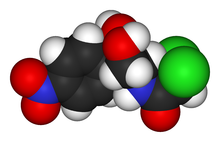Chloromycetin
 |
|
 |
|
| Clinical data | |
|---|---|
| Trade names | Pentamycetin, Chloromycetin, others |
| AHFS/Drugs.com | Monograph |
| MedlinePlus | a608008 |
| License data |
|
| Pregnancy category |
|
| Routes of administration |
Topical (eye drops), by mouth, IV, IM |
| ATC code | |
| Legal status | |
| Legal status | |
| Pharmacokinetic data | |
| Bioavailability | 75–90% |
| Protein binding | 60% |
| Metabolism | Liver |
| Biological half-life | 1.6-3.3 hours |
| Excretion | Kidney (5-15%), faeces (4%) |
| Identifiers | |
|
|
| CAS Number | |
| PubChem CID | |
| DrugBank | |
| ChemSpider | |
| UNII | |
| KEGG | |
| ChEBI | |
| ChEMBL | |
| ECHA InfoCard | 100.000.262 |
| Chemical and physical data | |
| Formula | C11H12Cl2N2O5 |
| Molar mass | 323.1320 g/mol |
| 3D model (Jmol) | |
|
|
|
|
Chloramphenicol is an antibiotic useful for the treatment of a number of bacterial infections. This includes as an eye ointment to treat conjunctivitis. By mouth or by injection into a vein it is used to treat meningitis, plague, cholera, and typhoid fever. Its use by mouth or by injection is only recommended when safer antibiotics cannot be used and if used monitoring both blood levels of the medication and blood cell levels every two days is recommended during treatment.
Common side effects include bone marrow suppression, nausea, and diarrhea. The bone marrow suppression may result in death. To reduce the risk of side effects treatment duration should be as short as possible. People with liver or kidney problems may need lower doses. In young children a condition known as gray baby syndrome may occur which results in a swollen stomach and low blood pressure. Its use near the end of pregnancy and during breastfeeding is typically not recommended. Chloramphenicol is a broad-spectrum antibiotic that typically stops bacterial growth by stopping the production of proteins.
Chloramphenicol was discovered in 1947. It is on the World Health Organization's List of Essential Medicines, the most effective and safe medicines needed in a health system. It is available as a generic medication. The wholesale cost in the developing world of an intravenous dose is about 0.40 to 1.90 USD. In the United States an intravenous dose costs about 41.47 USD. Global issues relating to bacterial resistance have revived interest in its use.
...
Wikipedia
